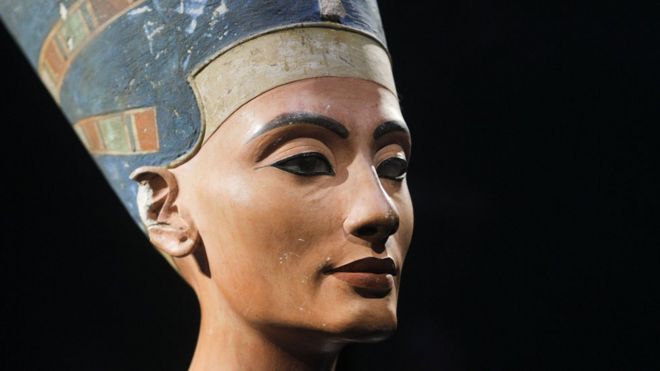
The Egyptian pharaoh queen Nefertiti could be buried in King Tutankhamun's tomb, says a British archaeologist.
Nicholas Reeves says he believes there may be two hidden doorways behind the Tutankhamun's burial chamber, leading to two undiscovered rooms.
Egyptian officials plan to use radar equipment to test Mr Reeves' theory that Nefertiti's remains were placed in one of them.
She was queen of Egypt during the 14th Century BC.
Mr Reeves believes the remains of Tutankhamun, who died 3,000 years ago aged 19, may have been rushed into an outer chamber of what was originally Nefertiti's tomb.
The remains of Tutankhamun, who may have been Nefertiti's son, were found in 1922.
Signs of a portal
Dr Reeves developed his theory after a Spanish company of artistic and preservation specialists, Factum Arte, were commissioned to produce detailed scans of Tutankhamun's tomb.
The scans were then used to produce a facsimile of the 3,300-year-old tomb near the site of the original Valley of the Kings in Luxor.
While assessing the scans last February, Dr Reeves spotted what he believed were marks indicating where two doorways used to be. The archaeologist from the University of Arizona says he believes Nefertiti may lie inside.
Egypt's Antiquities Minister Mamdouh el-Damaty hopes that non-invasive radar equipment can be used in the tomb within the next three months.
"If it is true, we are facing a discovery that would overshadow the discovery of Tutankhamun himself," said Mr Damaty.
Radar equipment "will confirm whether there's something" there, he added.
Tutankhamun's tomb was the most intact ever discovered in Egypt. Close to 2,000 objects were found inside.
But its layout has been a puzzle for some time - in particular, why it was smaller than those of other kings' tombs.
Dr Reeves believes there are clues in the design of the tomb that indicate it was designed to store the remains of a queen, not a king. His theory has yet to be peer-reviewed and leading Egyptologists have urged caution over the conclusion.
Some believe that Nefertiti's mummy was discovered in 1898 and is now in the Egyptian Museum in Cairo.
"The idea that one (doorway) might lead to a pre-existing burial chamber, let alone that of Nefertiti, is pure speculation," Aidan Dodson, an Egyptologist at Bristol University, told Reuters news agency.
 AFP/Getty Images
AFP/Getty ImagesWho was Queen Nefertiti?
- The name Nefertiti means "a beautiful woman has come"
- She was queen of Egypt and wife of Pharaoh Akhenaten during the 14th century BC
- She and her husband established the cult of Aten, the sun god, and promoted a new style of Egyptian artwork
- It is thought the couple married when Nefertiti was about 15 and had six daughters and a son
- Some theories hold that Nefertiti was the mother of King Tutankhamun



No comments:
Post a Comment